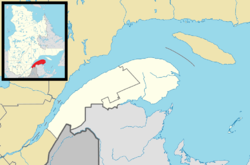Pointe-à-la-Croix, Quebec
| Pointe-à-la-Croix | |
|---|---|
| Municipality | |
 |
|
 Location within Avignon RCM. |
|
| Location in eastern Quebec. | |
| Coordinates: 48°01′N 66°41′W / 48.017°N 66.683°WCoordinates: 48°01′N 66°41′W / 48.017°N 66.683°W | |
| Country |
|
| Province |
|
| Region | Gaspésie– Îles-de-la-Madeleine |
| RCM | Avignon |
| Settled | 1750s |
| Constituted | May 7, 1983 |
| Government | |
| • Mayor | Jean-Paul Audy |
| • Federal riding | Gaspésie— Îles-de-la-Madeleine |
| • Prov. riding | Bonaventure |
| Area | |
| • Total | 416.90 km2 (160.97 sq mi) |
| • Land | 394.39 km2 (152.27 sq mi) |
| Population (2011) | |
| • Total | 1,472 |
| • Density | 3.7/km2 (10/sq mi) |
| • Pop 2006-2011 |
|
| • Dwellings | 725 |
| Time zone | EST (UTC−5) |
| • Summer (DST) | EDT (UTC−4) |
| Postal code(s) | G0C 1L0 |
| Area code(s) | 418 and 581 |
| Highways |
|
| Website | www |
Pointe-à-la-Croix (Cross Point in English) is a municipality located on the Restigouche River in the Gaspésie region of eastern Quebec, Canada. It is situated across from the city of Campbellton, New Brunswick.
In addition to Pointe-à-la-Croix itself, the municipality also includes the communities of L'Alverne, Oak Bay, and Saint-Fidèle-de-Ristigouche.
The municipality is home to the site of the Battle of the Restigouche, a National Historic Site of Canada, and the Petite Rochelle interpretive centre.
The adoption of the name Pt-a-la-Croix for this municipality was obviously done in haste without giving any consideration of its important historical heritage. It seems that their only consideration at the time was rapid francisation. I have no objections to that but I must state my objections on the choice of the name. As historian since more than thirty years in this area I have gained some insight on our history, and can state for a fact that Jacques Cartier declared this bay and river as a dead end therefore insuring its neglect in being populated; Jean Marie Thibault, (C E G E P de la Gaspésie) teaches that this is one of the most important reasons, besides the fact that in the days of sailing there simply was no reason to venture into the Bay of Chaleur and waste precious time while travelling between Canada and France. This place was never a crossroads to anywhere. Inventing history is called creationism.
The name La Petite Rochelle if it were chosen as the new name of this municipality would have instantly reconnected with the most important and heroic part of our local history. The origin of the name dates to 1684 when it was granted to Charles Damours youngest of the five sons of Mathieu Damours owner of the concession de Matane. La Seigneurie de Petite Rochelle extended from Ruisseau de L`Officier west and also included the concession of Matapedia. Charles was a fir trader with a questionable reputation. We have discovered many artefacts from a site in Restigouche-Sud Est. that may indicate a French establishment of the period (late 1600s). Further professional archaeological research should be done in this site. The Seigneurie was one of many which remained undeveloped. During the Battle of the Ristigouche an eyewitness description of the events of the third of July 1760 refers to a sort of village or group of Acadian dwellings numbering between 150 and 200, burned by the English. He says this village was called La Petite Rochelle. It was populated by 1003 Acadian refugees and 500 Métis Gaspesiens. Historically this was the one and only French place name ever used in reference to this area. The actual village, if one can call it that, had a short life span. It began as a stopping point for watercraft forced to wait at this place before being able to continue upriver. Just below and north of battery point a ship is well protected from the westerly wind. Off Battery point the channel is narrow creating a current of up to seven knots. To proceed upriver under sail from this place required an east wind and a rising tide; needless to say, the wait was sometimes long. This spot seems to have better suited the desperate Acadian refugee families arriving from southern Acadia. The first large group had arrived in 1757 with Joseph Leblanc dit Le Maigre. This group had spent the first winter near the Sugarloaf Mountain but transferred across to the place referred to as La Petite Rochelle in spring of 1760.
...
Wikipedia

